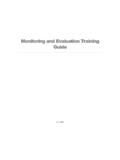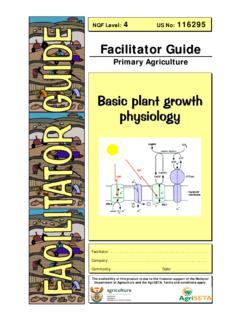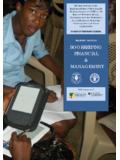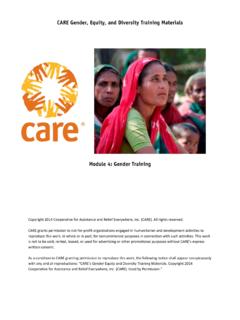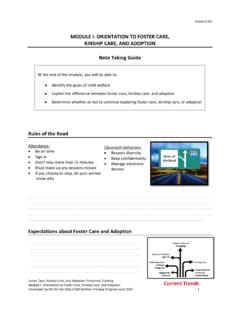Transcription of Mod B 08 clean - World Health Organization
1 4 RAINING #OURSE ON #HILD 'ROWTH !SSESSMENT7(/ #HILD 'ROWTH 3 TANDARDS training Course on Child Growth Assessment WHO Child Growth Standards Measuring a Child s Growth Department of Nutrition for Health and Development BWHO Library Cataloguing-in-Publication Data WHO child growth standards : training course on child growth assessment. "The project was designed and coordinated by Adelheid W. Onyango and Mercedes de Onis .."--Acknowledgements. Contents: A. Introduction -- B. Measuring a child's growth -- C. Interpreting growth indicators -- D. Counselling on growth and feeding -- E. Photo booklet -- Answer sheets -- Facilitator's guide -- Course director's guide -- Boy's growth record -- Girl's growth record -- Job aids. development. - methods. weights and measures - standards. assessment. materials. , Adelheid W. Onis, Mercedes. Health Organization . : World Health Organization child growth standards. ISBN 92 4 159507 8 (NLM classification: WS 103) ISBN 978 92 4 159507 0 World Health Organization 2008 All rights reserved.)
2 Publications of the World Health Organization can be obtained from WHO Press, World Health Organization , 20 Avenue Appia, 1211 Geneva 27, Switzerland (tel.: +41 22 791 3264; fax: +41 22 791 4857; e-mail: Requests for permission to reproduce or translate WHO publications whether for sale or for noncommercial distribution should be addressed to WHO Press, at the above address (fax: +41 22 791 4806; e-mail: The designations employed and the presentation of the material in this publication do not imply the expression of any opinion whatsoever on the part of the World Health Organization concerning the legal status of any country, territory, city or area or of its authorities, or concerning the delimitation of its frontiers or boundaries. Dotted lines on maps represent approximate border lines for which there may not yet be full agreement. The mention of specific companies or of certain manufacturers products does not imply that they are endorsed or recommended by the World Health Organization in preference to others of a similar nature that are not mentioned.))
3 Errors and omissions excepted, the names of proprietary products are distinguished by initial capital letters. All reasonable precautions have been taken by the World Health Organization to verify the information contained in this publication. However, the published material is being distributed without warranty of any kind, either expressed or implied. The responsibility for the interpretation and use of the material lies with the reader. In no event shall the World Health Organization be liable for damages arising from its use. The named authors alone are responsible for the views expressed in this publication. Printed in ChinaiiiTraining Course on Child Growth AssessmentWHO Child Growth StandardsAcknowledgementsThis training course has been prepared by the Department of Nutrition, World Health Organization , Geneva. The project was designed and coordinated by Adelheid W. Onyango and Mercedes de Onis who provided the main technical input. Contributions to the technical content by Chessa Lutter (AMRO/PAHO), Cutberto Garza (Boston, MA, USA) and Ilgi Ertem (Ankara, Turkey) are gratefully acknowledged.
4 The field-test version of the materials was reviewed in-depth by staff of the FANTA Project, USAID, and participants in the PAHO regional training of Trainers workshop in Barbados, May 2006. Version 1, published in November 2006 was reviewed during Regional workshops in EMRO (Cairo, February 2007), AFRO (Addis Ababa, June 2007), WPRO (Shah Alam, September 2007) and SEARO (Bali, October 2007). The comments and suggestions provided by participants at these workshops have been used to refine the course for this final printing. The course modules were developed and laid out by Patricia Whitesell Shirey and Florence C. Johnson of ACT International, Atlanta, Georgia, funds from the Bill and Melinda Gates Foundation, the course was field-tested in collaboration with the Caribbean Program Coordination, PAHO in Barbados, and its first version further tested and refined with the collaboration of the respective WHO Regional Offices (EMRO, AFRO, WPRO and SEARO) and the Country Offices in Ethiopia, Malaysia and Indonesia.
5 Suggested citation: World Health Organization . training Course on Child Growth Assessment. Geneva, WHO, : Measuring a Child s Growth 1 Module objectives .. 1 Use the Growth Start a new Growth 2 Record reason for visit and child s age today .. 4 Select pages of the Growth Record to use at this 7 Exercise A ..8 Exercise B .. Observe the child and note clinical signs of marasmus and kwashiorkor .. 12 Measure weight .. Prepare for 16 Weigh a child using tared 17 Weigh a child alone .. Measure length or height .. Prepare to measure length or 21 Measure 21 Measure standing height .. Care for measurement equipment .. Determine BMI (body mass index).. 27 Exercise C .. 30 Exercise D .. 32 Answers to short answer exercises .. 34 Annex I: Sample Local Events Calendar .. 35 Annex II: BMI ::MMeeaassuurriinnggaaCChhiilldd ssGGrroowwtthh 1B: Measuring a Child s Growth IntroductionThis module describes how to determine a child s age; recognize clinical signs of certain serious problems of undernutrition; measure a child s weight and length or height; and determine a child s BMI (body mass index).
6 The child s age, sex, and measurements of weight and length or height will be used to calculate the following growth indicators, which will be described in the next module: xlength/height-for-agexweight-for-agexwe ight-for-length/heightxBMI (body mass index)-for-age The measurements described in this module should be taken and recorded whenever an infant or child visits a Health care provider, for example, for an immunization, a well-baby visit, or care during an illness. There is no WHO-recommended schedule of visits specifically for growth assessment, but some countries may recommend a schedule, such as 6 visits in the first 2 years of life. Module objectivesParticipants will learn how to: Refer to section: xStart a Growth Record for a child and select pages to use , at a given visit. xDetermine a child s age today. xRecognize clinical signs of marasmus and kwashiorkor. xWeigh a child and record weight. xMeasure and record length or height.
7 XDetermine BMI (body mass index) by referring to a table or using a calculator. BB::MMeeaassuurriinnggaaCChhiilldd ssGGrroowwtthh Use the Growth Record AGrowth Record is a booklet that contains all of the charts needed to record and assess the growth of a child from birth up to 5 years of age. A different Growth Record is needed for boys and girls because boys and girls have different weights and lengths beginning at birth. Boys and girls need to be assessed by standards that reflect normal differences in their sizes. AGrowth Record should be started for each child and kept by the mother. When a child visits the Health facility, ask the mother if the child has a Growth Record. If not, start a GrowthRecord as described in section If the child already has a Growth Record, obtain it from the mother and record today s visit as described in sections and a child s Growth Record has been left at home, record information on whatever back-up register or record is available at the Health facility, and update the child s Growth Record at the next visit.
8 If a child s Growth Record is lost or destroyed, replace it if supplies permit. Praise the mother for having her child s growth assessed regularly. Start a new Growth Record Depending on the sex of the child, select a Boy s Growth Record or Girl s Growth the Growth Record to the mother and explain the following points: xThis booklet will be your record of your child s growth and Health . xEach time you visit, your child will be weighed and measured, and the measurements will be recorded in this booklet. xThe booklet includes charts on which we will plot your child s measurements in order to assess his or her growth. xIt has a schedule of immunizations to show when your child needs and receives has recommendations about feeding your child and important points about caring for your child at different ages. xKeep this booklet in a safe place and bring it with you whenever you bring your child to a Health facility. Complete page 1 of the Growth Record (Personal Data, opposite) by asking questions of the mother and reviewing any relevant documents that the mother may have, such as a Health card or birth ::MMeeaassuurriinnggaaCChhiilldd ssGGrroowwtthh 3 Personal Data Child s name _____Identification/Record number _____ BoyParents names _____ _____ Address _____ _____ Birth information: Date of birth _____ Gestational age at birth _____ Single/multiple birth?
9 _____ Measurements at birth: Weight _____ Length _____ Head circumference _____ Birth rank _____ Date of birth of next younger sibling (born to mother)_____ Feeding:Age at introduction of any foods or fluids _____ Age at termination of breastfeeding _____ Adverse events (dates): (such as death of parent, death of sibling age <5 years)_____ _____The date of birth (day/month/year) is especially important. If the date is not documented, ask the mother. If she does not know the date, ask her questions to determine the date as closely as possible; for example, ask when the birth occurred in relation to a local event or holiday. The gestational age at birth ( the number of weeks of pregnancy) may be recorded in the child s birth record. If not, ask the mother and record whether the baby was term(37 41completed weeks of pregnancy), pre-term (before 37 weeks), or post-term (42 weeks or more).Ask and record whether this child was a single or multiple birth.
10 Record other data related to the child s birth if documented, for example, weight, length, and head circumference at birth. Ask the mother about the child s birth rank ( order). For example, ask: Is this your first child, second child, Include all live births in order, even if an older sibling has died. For example, if the child is the second-born, but the older sibling has died, you would still record the birth rank as the mother has had other children after this child, ask when her next younger child was born. Depending on the child s age, ask appropriate questions to determine whether the child is still breastfeeding either exclusively or with other foods and fluids. If other foods or fluids have been introduced, ask and record the age at which they were introduced. If the child is no longer breastfeeding, ask and record the age at termination of a girl, must use a Girl s Growth Record More details of feeding history may be recorded in Visit Notes BB::MMeeaassuurriinnggaaCChhiilldd ssGGrroowwtthh 4 Ask about any adverse events that may affect the child s Health .










